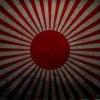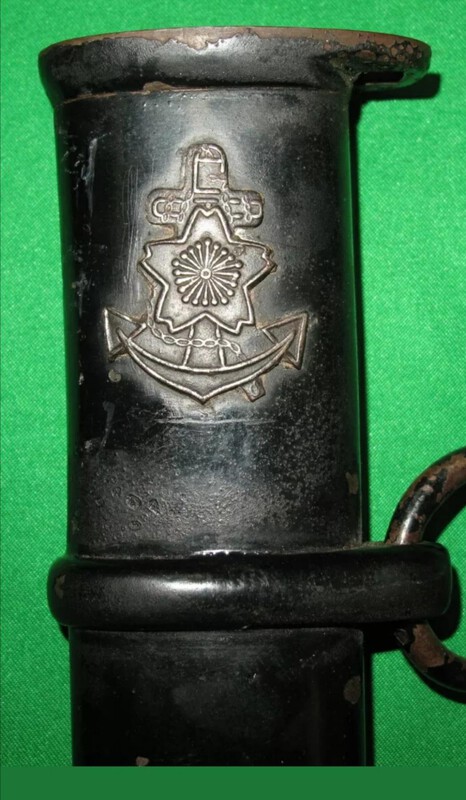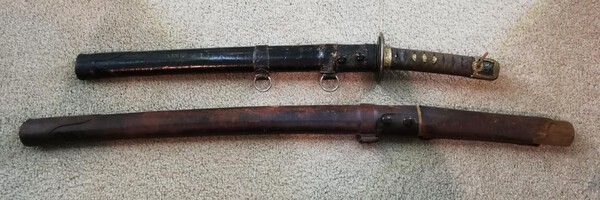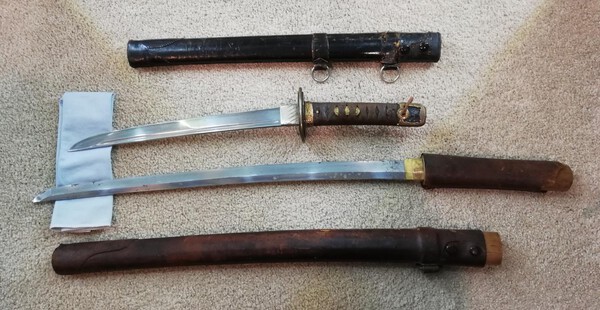-
Posts
1,402 -
Joined
-
Last visited
-
Days Won
12
Content Type
Profiles
Forums
Events
Store
Downloads
Gallery
Everything posted by Shamsy
-
I think there are probably three reasons why, though it's just my opinion: 1) They are very collectable and easier to identify originals than other swords 2) The is huge increase in knowledge available to collectors of these swords in the last few years, due to dedicated efforts of people like Nick 3) The big one: there is an end. You could have millions of dollars and spend a lifetime and you'll never have a 'complete' collection of officer swords. However, there are 8 patterns of 95s. Easily achieved. Then, if desired, you can expand that collection by any number of factors. Arsenal, variations, stamps...
-
Quality will always improve, until the originals are nearly indistinguishable from the copies. But any collector of German militaria has been painfully aware of this for decades.
-
Yep. As was bound to happen when something goes from meh to suddenly commanding higher prices than what are frankly very nice, respectable officers swords. I'm glad there's so little information published on these swords, or we'd have more eBay monkeys on the drills and punches, suddenly making extremely rare variations more common than an unadulterated sword. There's a reason half these swords have less than 2 dozen known examples, and that's because there are so few examples for people to see! The idea that all rip-off merchants are lazy and shonky is entirely far fetched too. Just ask any collectors of German militaria. When a sword has reached $1,100USD 15 hours before closing, it's worth a little effort.
-
Yes, the black is period! That's not the issue with the sword. I've obviously missed the mark with the initial post. I was trying to get the point across that black paint is period, not original, but the message was lost in my suspicion of the sword. Pretty much all of the period black repaint seem to be in spotty condition. I think the black, semi gloss used was of poor quality and not very well applied. They usually don't have the same wear pattern indicative of use so I think they were probably done a bit later in the war (some loose evidence based conjecture).
-
They are! Maybe I wasn't clear enough on that point... There are plenty of modern black respray. However, there are plenty of evidently period black painted saya on 95s. They are not original though in my opinion. They are repainted from the original green/brown at some stage, maybe in the field once the original paint was badly degraded (conjecture!). They weren't issued like that. They are legitimate wartime swords though. Oh, edit to add that the very poor quality examples of 98s with wooden scabbard and Seki inspection stickers were all black. Completely legitimate pattern.
-
We're all aware of your opinions regarding 95s. Please don't share them. Oh we agree on something! Amazing! Yes, the three books are aged and incorrect on so many aspects. I couldn't agree more! I've had many great bargains thanks to the ignorance of potential rivals. I remember not that long ago when an early aluminium handle was called fake because so few people are aware of the difference. Yes I'm sure the owner of the sword (the Emperor of Japan) would have added the symbol! Okay, seriously, I would have thought it obvious that this is not original, but hey. As I said, the black paint is of the correct patina and age. Shame about the obvious sanding where the symbol is. That metal certainly lacks the same patina as the other bare patches. There are plenty of 32s in black. See the part where I mention that the black paint is period, but not original. You seem to love trying to contradict whatever I share, which is fine. It's good exercise. As I never got a right of reply in the last thread where you demonstrated your expertise with the 32s, yes, I am aware that there are 32s which were employed by and stamped by foreign armies. F&G mention it briefly in their book from 1996. Old news.
-
Logan, you and I share the same suspicion.
-
I was getting a bit of a laugh at the enthusiastic bidding, but I thought I'd better say something. I'm sure most members that care for such swords are aware of this one (and keeping it secret). https://www.ebay.com/itm/Very-Interesting-Japanese-WW2-NCO-Navy-Sword-Matching-Scabbard/133091062265?hash=item1efcd871f9:g:YwIAAOSwZbFdC73w Rather than let people down, better to share my opinion. Which is just that, though backed up with experience and some research from Nick. Firstly: every black painted saya I have been able to get my hands on is not original. Hold on there before you desperately defend your treasure! To clarify, I've seen two kinds: 1) modern respray, sometimes with or without aging effects 2) genuinely aged patina on black saya. However, these have all, without exception, had remnants of the original brown/green paint. So obviously, that begs the question. Are the original? Well as far as I'm concerned, no. BUT they do appear to be period. Now research I mentioned. Nick was asked about black saya. They were never issued or listed in provisions. As far as he's concerned, they're not authorised. So why do we see them? Insert conjecture here. Now, after a long and disjointed rant, I'm going to categorically state that the listed and pictured 'interesting sword' certainly is interesting! Because it looks so obviously post war. Obvious scratches where the black paint was removed. A rather shiny area around the design where the steel patina does not match with the rest of the saya. Then the more opinionated side. If you're going to personalise a saya, wouldn't you at least paint over your addition? I mean really? The Japanese were not lazy or sloppy people by any stretch. It's ridiculous to think that after a repaint to black (yeah, the original brown even shows in the picture) that someone thought to sand it down and add a motif. Unless of course you think it would be a good way to attract attention. It is my opinion this sword has been tarted up post war, ruining a perfectly good example of a legitimate black repaint. Okay, let's hear all the defensive comments and justification now. Oh,before the omnipotent Dawson is quoted (great book and such a boon to the collecting community), "just because it is written does not make it so" - Frankie Four-fingers. Dawson has made a few mistakes in the book.
-
They have as many or as few seppa as necessary. Simply add more of the correct size and material as required. Or make a leather one yourself.
-
It's also worth noting that 'Japs' is a derogatory term we do not use here.
-
I have a triangular wire sarute I bought from a gentleman selling lots of spare 98 and 95 parts. He thought it was a 95 but it's not the right size or shape, so I assumed a 98. Glad that's confirmed.
-
I disagree, Paul. At least in so far as I am enjoying the discussion regarding terminology and would like to see it continue. I do agree though that this thread has been otherwise derailed. Perhaps an administrator would kindly snip the thread, leaving one to discuss Kao Isshin and creating one for terminologies?
-
Interesting discussion on gunto. Like Bruce, I read that it translated to army sword.
-
I decided long ago that I'd love to learn about traditional swords and I even started purchasing some to admire. Not all cheap ones either. Then I realised that I felt no need for ownership. It was purely a study, about learning and knowledge. Militaria, now that's collecting at its finest. Not to mention military history is a particular interest of mine. So it was an obvious choice. Collect militaria, study books covering nihonto. I sold my swords and started a collection. Probably for the best, as militaria powers ever upwards in value while nihonto seems to have badly lagged.
-
I think you're right, Bruce. I had a look and compared a few. I thought the kabutogane hole has a little smaller and the fact the saya was wooden... However, the rest of the koshirae looks rather typical rinji.
-
I'm afraid I can't post a link, but check out ebay item number 333171112364 for another of these swords.
-
The best part about that 95 Neil is that neither of the tsuka screws are in the least bit damaged, meaning that there is little to no chance that the tsuka was repainted. I have a couple of copper handles in similar mint condition. One at least had a leather combat cover that protected the saya. The other I'm not sure. Both have leather sarute, one ruined unfortunately. Your sword may have been wartime refurbished, or perhaps it had an easy life or was forgotten. Lovely example, though I like field wear on all my swords. Just preference.
-
As Stegel has already said, I have seen a few undrilled handles for sale. I suspect some were added to swords later to increase value and curiosity. I think these are genuine frankly, because they are such high quality. I've never seen a fake or repro close. Having said that, I've not had one in hand, so can't be sure.
-
Interesting topic change. Carry on.
-
Okay, the picture of the 95 drew me in! Yep, agree that's what it appears to be, which considering the tassel makes sense. The short sword myth was dispelled years ago, Jareth. But it is a good marketing ploy, so it's sure to stay with us for a long time yet! I thought I'd post a couple of the wakizashi in my collection, as newer members may not have seen them and they're interesting (well I think so). First, my lovely little wak in naval koshirae. It's JUST too long to classify as a tanto, but you can see that in comparison, it's really short. Old blade signed, little ware but still nice and solid. The koshirae is sized appropriately, with a very petite tsuka. The kabuto-gane appears to be regular size, as does the tsuba. Obviously the habaki is custom, and the sarute is silk. The wakizashi in shirasaya is old but low quality. No awards for this, though you can see the hamon which is nice. Sadly you can also see the patches of rust on the blade which I suspect are finger prints. The shirasaya is covered in leather for wartime use, which other than the handle has survived really well. It's a nice little piece, which given my fondness of leather covered swords (don't read into), has managed to avoid the cull I did 10 years ago. It's also not likely to be worth much, so why get rid of something you like and appreciate if it won't even fetch a 95? Enough rambling.
-
I know mate, it's easier since most people learn the other name. Remember that the Rinji were produced to a 'fixed price', so (conjecture) it's possible that for some producers, corners were cut for profit. Alternatively, it may simply be a case of available materials, skill or even the need to produce swords as quickly as possible. You see a similar devolution with the 95s, in materials and craftmanship. Of course there are exceptions, with some swords (Seki 95s being a good example) maintaining a higher quality than others even late in the war, so it's a guess until something solid is proven. It could just be a poor man's version of a poor man's sword. The Rinji were still pretty solid swords and I seem to recall Nick thinking the fixed cost was somewhat hopeful.
-
I imagine this is very much the same scenario you find regularly with 95s. They all look alike to a casual observer, but when you drill down into the detail, you find that the various makers all produced the same pattern of sword, but with small variations. I'd say that since the Rinji Seishiki gunto (commonly and incorrectly called 'Type 3') was a standardised pattern but very much produced through private enterprises, it would be perfectly feasible that there will exist subcategory variations, like the one you have here, Neil. Whether or not the fact the blades are all Katsumasa made is tantalisingly close to suggesting a link between the koshirae and blade, but it'd be better to see if a larger sample can be obtained before leaping to a premature conclusion.
-
Sorry Bruce, a little misleading on my part. Still a long way off having something to publish.
-

From Iwo Jima, Feb. 1945, Showato or earlier?
Shamsy replied to lambo35's topic in Military Swords of Japan
Owww. Not my field, but looks old... This should be interesting. -
I'm glad Bruce brought up the fact that there has already been extensive research performed for 95s,and mostly outside of America, would you believe Great job Dan. There's nothing wrong with restoring 95s. Electrolysis is the best way to remove the rust without losing any of the 'good' steel, but that's pretty extreme. You've done a good job. I'm not for repainting, but luckily the saya looks good. I'd not worry about the tsuka. Plenty of nearly white handles out there and it's not much of a detractor. The best swords are not those in mint condition, but those with the correct amount of patina and wear to show they were carried or used (but obviously not extreme wear). They seem to be the best investment around, and once the book is written I'm sure they'll have another great surge in popularity.





